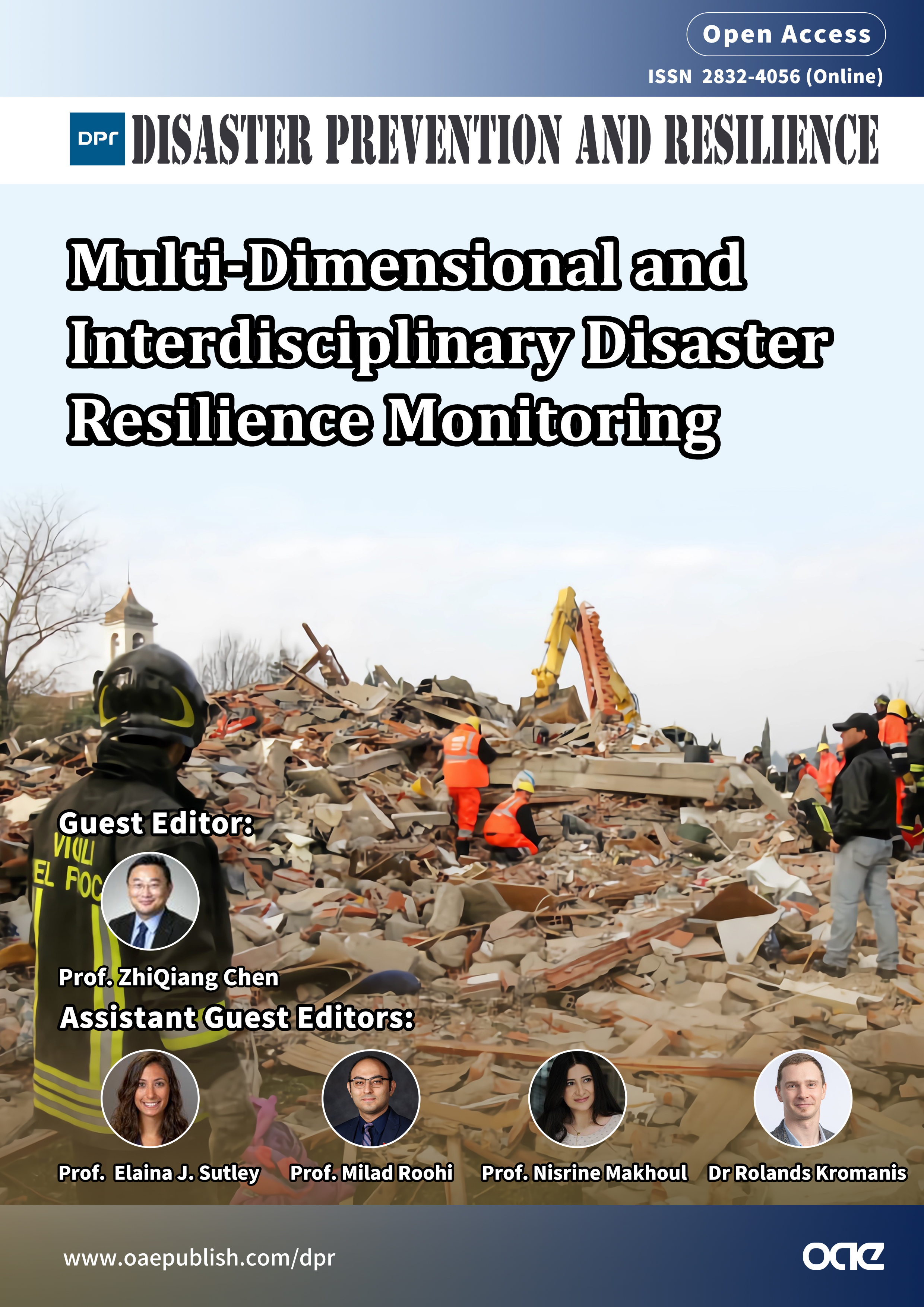
Topic: Multi-Dimensional and Interdisciplinary Disaster Resilience Monitoring
A Special Issue of Disaster Prevention and Resilience
ISSN 2832-4056 (Online)
Submission deadline: 30 Nov 2024
Guest Editor(s)
Assistant Guest Editor(s)
Prof. Elaina J. Sutley
Department of Civil and Environmental Engineering, University of Kansas, Lawrence, KS, USA.
Prof. Milad Roohi
Durham School of Architectural Engineering and Construction, University of Nebraska–Lincoln, Omaha, NE, USA.
Special Issue Introduction
It has long been established that the notion of resilience spans four interrelated dimensions: technical, organizational, social, and economic, collectively referred to as the TOSE dimensions. Therefore, the challenge of developing quantitative methods for measuring resilience has been recognized as early as the 2000s, necessitating researchers to break out of the silos of disciplines. In recent years, we have witnessed prolific, inter-, or even trans-disciplinary endeavors toward measuring and assessing the resilience of civil structures and infrastructure systems. However, we argue that in the arena of multi-dimensional system resilience modeling, most research approaches rely on unverified assumptions and lack support for data. Taking the analogy of structural health monitoring (SHM) and its pivotal relevance to and beneficial impact on structural diagnosis and prognosis, performance-based design, and life cycle structures and infrastructure management, we assert that novel monitoring techniques and innovative solutions are imperative for disaster risk mitigation and disaster resilience pertinent to civil structures, infrastructure systems, and communities.
Disaster Resilience Monitoring is a specialized field of study and application that focuses on developing and implementing monitoring strategies and technologies to enhance the resilience quantification and assessment of critical infrastructure, lifeline structures, and communities when disrupted by natural or man-made disasters. New knowledge, methods, and solutions for this field will directly influence the forthcoming resilience-based engineering design, resilience-based life-cycle maintenance and management, and the nexus of system resilience and sustainability. However, we assert that the challenges in developing disaster resilience monitoring are unparalleled compared to the traditional SHM methods, which entails the fusion of broader discipline knowledge (engineering, electronics, computing, geoscience, social and behavioral sciences, and others), sensing and modeling at higher range of scales (global, regional, community, structures/infrastructure, to individual), and processing and understanding of more heterogeneous data modalities (images, language, maps and graphs, time-series, etc.).
This Special Issue is dedicated to exploring cutting-edge monitoring and modeling methodologies and technologies to enhance the disaster resilience of civil infrastructure, critical structures, and communities. We invite research, review, and case-study articles that address the monitoring and modeling challenges from all phases of disaster resilience, including preparedness, response, and recovery. We especially solicit articles from interdisciplinary researchers or research teams that advance the frontier of Multi-dimensional and Interdisciplinary Disaster Resilience Monitoring. Suggested topics include, but are not limited to:
● New theories and mathematical frameworks for multi-dimensional and interdisciplinary disaster resilience sensing and modeling;
● Geological and climatic disasters and global and regional monitoring, and impact assessment using satellites and unmanned air/ground vehicles or other sensing modalities;
● Novel conjunction of SHM with disaster resilience sensing;
● Innovative sensing solutions in the areas of sensor networks, robotic sensing, Internet of Things, and crowdsourcing/human sensing (including online surveys) and their applications at all phases of civil systems and community resilience;
● Novel crowdsourcing and human computing methods for disaster preparedness, response, and recovery;
● Novel use of sensing and modeling solutions at the social, organizational, and economic dimensions;
Novel data-driven mining, machine learning, generative artificial intelligence (AI), and digital twining methods;
● Nexus of social and behavioral sciences with technical solutions for disaster resilience, including technology-based social surveys, risk perception and communication, and resilience-based decision-making;
● Disaster debris sensing, measurement, and management.
Disaster Resilience Monitoring is a specialized field of study and application that focuses on developing and implementing monitoring strategies and technologies to enhance the resilience quantification and assessment of critical infrastructure, lifeline structures, and communities when disrupted by natural or man-made disasters. New knowledge, methods, and solutions for this field will directly influence the forthcoming resilience-based engineering design, resilience-based life-cycle maintenance and management, and the nexus of system resilience and sustainability. However, we assert that the challenges in developing disaster resilience monitoring are unparalleled compared to the traditional SHM methods, which entails the fusion of broader discipline knowledge (engineering, electronics, computing, geoscience, social and behavioral sciences, and others), sensing and modeling at higher range of scales (global, regional, community, structures/infrastructure, to individual), and processing and understanding of more heterogeneous data modalities (images, language, maps and graphs, time-series, etc.).
This Special Issue is dedicated to exploring cutting-edge monitoring and modeling methodologies and technologies to enhance the disaster resilience of civil infrastructure, critical structures, and communities. We invite research, review, and case-study articles that address the monitoring and modeling challenges from all phases of disaster resilience, including preparedness, response, and recovery. We especially solicit articles from interdisciplinary researchers or research teams that advance the frontier of Multi-dimensional and Interdisciplinary Disaster Resilience Monitoring. Suggested topics include, but are not limited to:
● New theories and mathematical frameworks for multi-dimensional and interdisciplinary disaster resilience sensing and modeling;
● Geological and climatic disasters and global and regional monitoring, and impact assessment using satellites and unmanned air/ground vehicles or other sensing modalities;
● Novel conjunction of SHM with disaster resilience sensing;
● Innovative sensing solutions in the areas of sensor networks, robotic sensing, Internet of Things, and crowdsourcing/human sensing (including online surveys) and their applications at all phases of civil systems and community resilience;
● Novel crowdsourcing and human computing methods for disaster preparedness, response, and recovery;
● Novel use of sensing and modeling solutions at the social, organizational, and economic dimensions;
Novel data-driven mining, machine learning, generative artificial intelligence (AI), and digital twining methods;
● Nexus of social and behavioral sciences with technical solutions for disaster resilience, including technology-based social surveys, risk perception and communication, and resilience-based decision-making;
● Disaster debris sensing, measurement, and management.
Keywords
Disaster resilience, structural resilience, community resilience, resilience monitoring, resilience quantification, risk perception, communication, mitigation, sensing and modeling, structural health monitoring, emergency response, sustainable and resilient infrastructure
Submission Deadline
30 Nov 2024
Submission Information
For Author Instructions, please refer to https://www.oaepublish.com/dpr/author_instructions
For Online Submission, please login at https://oaemesas.com/login?JournalId=dpr&IssueId=DPR240105
Submission Deadline: 30 Nov 2024
Contacts: Lyric Zhang, Assistant Editor, Lyric@oaeservice.com





